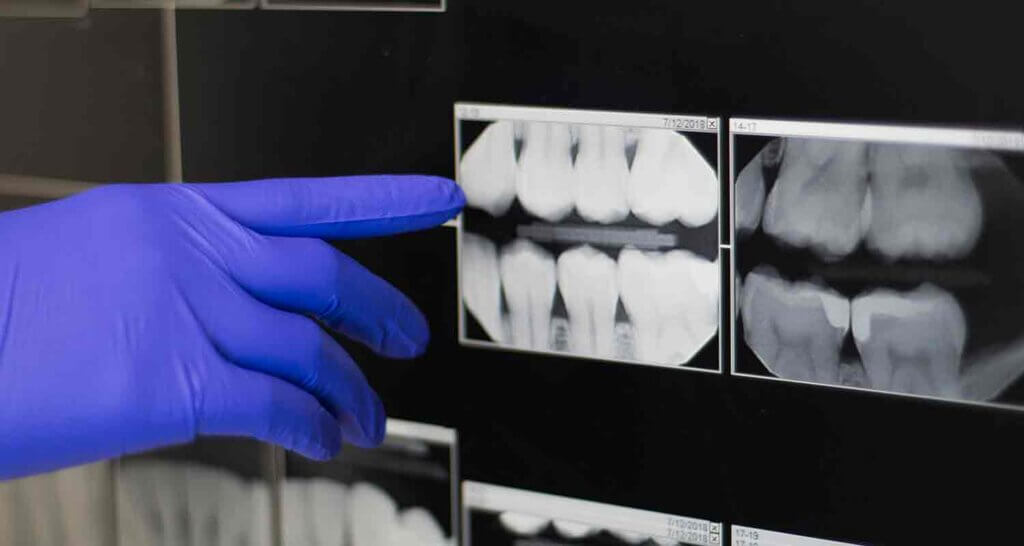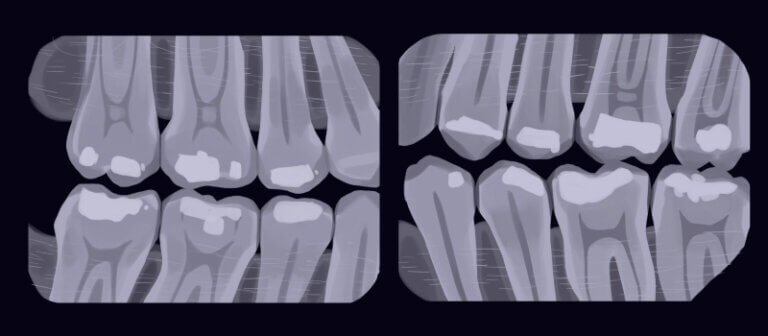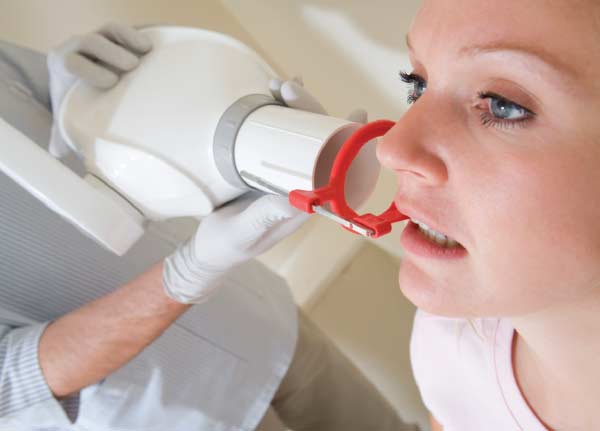Bitewing X-Rays

What Are Bitewing X-Rays?
Bitewing X-rays are a common and essential diagnostic tool used by dentists to assess the health of your teeth and gums. Named for the small “wing” or tab that you bite down on to hold the X-ray film in place, these images provide a clear view of the upper and lower teeth in a single area of the mouth. Unlike traditional X-rays, bitewing X-rays focus specifically on the areas between the teeth and the height of the bone, making them particularly useful for detecting cavities (tooth decay), monitoring the health of dental restorations, and checking for bone loss associated with gum disease. Regular bitewing X-rays can help your dentist catch dental issues early, ensuring you receive timely and effective treatment.
Before deciding on whether Bitewing X-Rays are right for you, there are some things you should know:
- Who Needs Bitewing X-Rays?
- Benefits Of Bitewing X-Rays
- How Much Do Bitewing X-Rays Cost?
- Steps In The Bitewing X-Ray Procedure
- Can I Have Bitewing X-Rays If I Am Pregnant?
- Frequently Asked Questions About Bitewing X-Rays
If you have any further questions about Bitewing X-Rays or other dental services offered at Atlas Dental, please contact us.

Free phone consultation
Have questions about Bitewing X-Rays? Schedule a free phone consultation with our Toronto dentist.

5 star google reviews
Our patients love us! See for yourself why more and more people are choosing Atlas Dental for their Bitewing X-Rays.

Book Bitewing X-Rays Scan Online
We provide quick and convenient Bitewing X-Rays Scan Service in Toronto. Book Online.
Who Needs Bitewing X-Rays?
Bitewing X-rays are a common part of routine dental care and are recommended for several groups of patients:
- Children and Teens: Bitewing X-rays are vital for monitoring developing teeth and spotting early signs of cavities, which are common in younger patients.
- Adults: Routine X-rays help detect cavities in hard-to-see areas and assess the condition of older dental work, like fillings or crowns.
- Patients with Dental Restorations: Individuals with fillings, crowns, or a history of gum disease benefit from regular X-rays to catch any new issues or monitor existing conditions.
- Patients with Dry Mouth: Xerostomia (dry mouth) increases the risk of cavities, making bitewing X-rays essential for early detection.
- First-Time Dental Visits: New patients often receive bitewing X-rays to help the dentist get a complete picture of their oral health.
Regular bitewing X-rays help prevent serious dental problems by catching early signs of trouble. If you have further questions about Bitewing X-Rays, please contact us.

Benefits Of Bitewing X-Rays
Bitewing X-rays offer many advantages, making them an important part of your regular dental care:
- Early Cavity Detection: X-rays can reveal cavities between teeth before they become visible, allowing for early treatment.
- Monitoring Fillings and Crowns: These X-rays assess the condition of dental restorations, spotting issues like wear or leaks that may need attention.
- Bone Health Assessment: Bitewing X-rays show the level of bone surrounding teeth, making them essential for managing gum disease and bone loss.
- Detecting Other Issues: Besides cavities, bitewing X-rays can also reveal abscesses, cysts, or impacted teeth, which can help in treatment planning.
- Quick and Comfortable: The process of taking bitewing X-rays is quick and easy, making it a hassle-free part of your dental visit.
- Low Radiation: Modern digital bitewing X-rays use very low levels of radiation, making them a safe choice for routine check-ups.
- Accurate Diagnoses: The high-quality images allow dentists to make precise diagnoses, which means you get the right treatment.
By including bitewing X-rays in your dental visits, you ensure your dentist can spot potential issues early. This proactive approach supports your overall oral health. If you have further questions about Bitewing X-Rays, please contact us.
Cost of Digital Dental X-Rays Images
The cost of Digital Dental X-Ray Images will depend on the type of image taken as well as the number of images. Example x-ray codes in the Ontario Dental Association’s Suggested Fee Guide appear as follows:
- 02111 – Single image: $41
- 02112 – Two images: $48
- 02113 – Three images: $56
- 02114 – Four images: $63
- 02115 – Five images: $74
- 02116 – Six images: $82
- 02117 – Seven images: $92
- 02141 – Single image: $41
- 02142 – Two images: $48
- 02143 – Three images: $56
- 02144 – Four images: $61
Radiographs, Regional/Localized
- 02101 – Radiographs, Complete Series (minimum of 12 images incl. bitewings): $166
- 02102 – Radiographs, Complete Series (minimum 16 images, incl. bitewings): $179
- 02601 – Single images: $84
Dental X-Rays are considered a basic service under all dental insurance plans and should be covered to your maximum insurable limit, but be sure to find out from your dental insurance plan provider how much you are eligible for before going ahead with dental treatment. Our fees are consistent with the ODA Fee Guide.
For patients without dental insurance, Atlas Dental is pleased to offer dental financing through iFinance Dentalcard. Affordable payment plans start at 7.95% for terms of 6 months to 6 years. To learn more about Dentalcard dental treatment financing, follow this link.
Steps In The Bitewing X-Ray Procedure
Wondering what happens during a bitewing X-ray? Here’s a quick guide:
- Preparation: You’ll wear a lead apron to shield you from radiation. Remove any metal objects, like retainers or dentures.
- Positioning: You’ll bite down on a wing-shaped device that holds the X-ray sensor in place.
- Taking the X-Ray: The dentist will position the X-ray machine next to your cheek and take the image in just a few seconds.
- Multiple Views: To get a complete picture, the process may be repeated for other areas of your mouth. Typically, four bitewing X-rays are taken.
- Image Review: If digital X-rays are used, the images will be available right away. Your dentist will review them with you.
- Next Steps: Your dentist will discuss any findings and recommend treatments if needed.
The procedure is quick, painless, and provides valuable information to keep your teeth and gums healthy. If you have further questions about Bitewing X-Rays, please contact us.

Can I Have Bitewing X-Rays If I Am Pregnant?
If you’re pregnant, you might be concerned about X-rays. Here’s what you should know:
- Inform Your Dentist: Always let your dentist know if you’re pregnant. Non-urgent X-rays can often be postponed, but if needed, they can be performed safely.
- Precautions: If an X-ray is necessary, extra precautions like a lead apron will be used to protect you and your baby.
- Low Risk: Modern digital X-rays use very low radiation, minimizing any risk during pregnancy.
It’s important to maintain your oral health while pregnant, and bitewing X-rays can be performed safely when necessary. If you have further questions about Bitewing X-Rays, please contact us.
Frequently Asked Questions About Bitewing X-Rays
- Are bitewing X-rays safe?
Yes, bitewing X-rays are safe when performed with modern digital imaging, which uses minimal radiation. Your dentist also uses protective measures like lead aprons to further ensure your safety.
- How often should I get bitewing X-rays?
The frequency depends on your dental health and risk of cavities, but most people need them every 1-2 years. Your dentist will recommend a schedule tailored to your needs.
- Can I refuse bitewing X-rays?
Yes, you can decline them, but it may limit your dentist’s ability to detect hidden cavities or other issues. Discuss your concerns with your dentist to find the best approach for your care.
- Do bitewing X-rays hurt?
Bitewing X-rays are generally painless, but you may feel slight discomfort from the X-ray sensor. Let your dentist know if you experience any significant discomfort.

